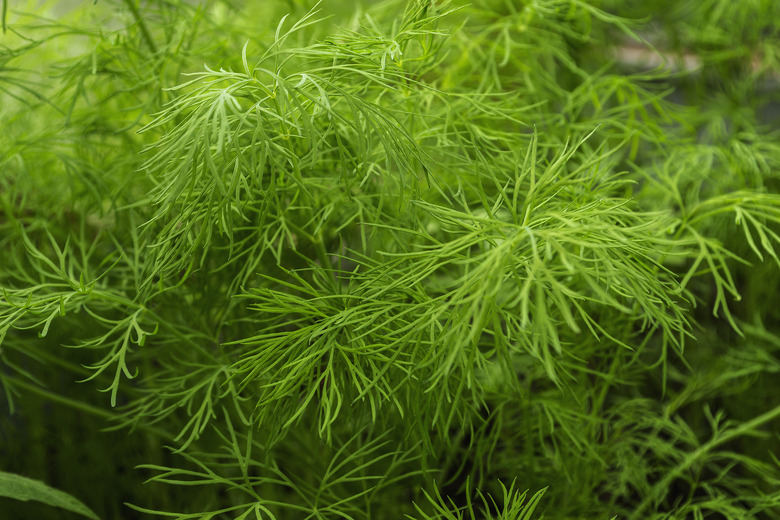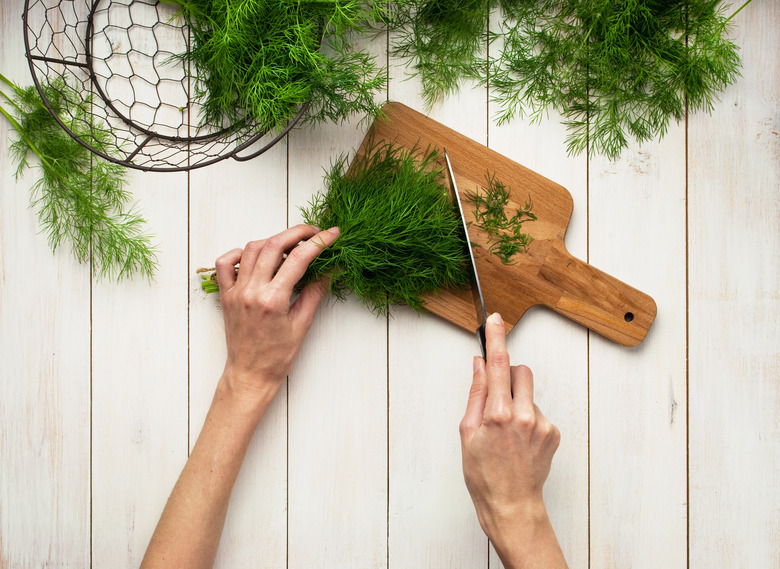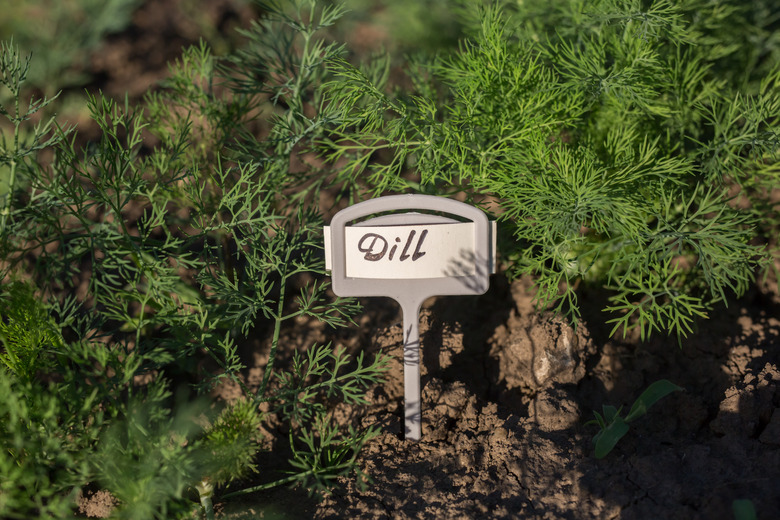How To Grow Dill
When you think of dill (Anethum graveolens), you probably imagine a jar of tasty dill pickles. They're so-named because they're flavored with — you guessed it — dill. Dill is an annual herb with feather-like foliage and a distinct aroma. Dill plants are self-seeding, so while they die back each year, you're likely to have a few volunteer plants pop up the following spring.
Dill is part of the parsley plant family (Apiaceae or Umbelliferae), a group of flowering plants with aromatic qualities. Plants in this family have a hollow taproot and stem along with unique, flat-topped blooms called umbels. Other umbellifers include parsley, celery, carrot, anise, chervil, cilantro, cumin, fennel, parsnip and lovage.
Dill plants flower in the summer and are relatively easy to grow. Dill is sometimes called dill weed because it has such a hardy disposition. The yellow blooms on the dill plant attract a variety of pollinators, including butterflies.
Best Uses for Dill
Best Uses for Dill
Dill is typically grown for its culinary uses. The herb, commonly used in pickling, provides a distinct flavor to pickled vegetables. Cookingwise, it also goes well with fish and tastes great in soups and stews. Fresh dill tastes more fresh and bright than dried dill does, and a little goes a long way.
You can also plant dill to attract pollinators and beneficial insects like butterflies. Dill and other plants in the same family do attract black swallowtail butterflies, which are pollinators that sometimes act like pests. The caterpillars are eating machines. If you're a fan of carrots and have trouble with black swallowtail butterfly caterpillars munching on their leaves, you can plant dill and other umbels to dissuade the larvae from feeding on your preferred plants.
Dill, like other herbs, thrives equally well in containers as it does in the ground. It's commonly grown in herb gardens. However, because dill has attractive blooms, you might also consider planting it among flowers. It does best in full sun, so pick an area of your garden or yard where it will get plenty of exposure to sunlight, at least six hours. Although dill is an annual herb (technically a biennial but a very short-lived one), it does self-seed. It's possible to establish a dill patch if you let plants go to seed at the end of the season. Be careful, though — because dill is quite hardy, it can quickly become overgrown. Harvest frequently and avoid letting large swaths of dill plants go to seed.
How to Grow Dill
How to Grow Dill
Starting Dill From Seed
It's best to direct-seed dill straight into its growing location. Whether you plan to grow it in a container or in a garden bed, plan on direct sowing and not transplanting. Like its cousin the carrot, dill doesn't like being transplanted. Most plants with a taproot dislike being disturbed once rooted.
Ideal germination conditions for dill seed include soil temperatures between 60 and 70 degrees Fahrenheit. Seeds should sprout in about 10 to 14 days. It can take longer if the soil temperatures are slightly outside of this range.
Start seeds outside and after your last frost date. You can attempt to start dill seeds indoors several weeks before your last frost date, but don't be surprised if your seedlings don't take well to the transplanting process. Sow seeds about 1/4 inch in depth and keep plants at least 18 inches apart from one another.
Dill also self-sows if you leave the seed heads in place at the end of the season. If you plan to save seeds, let your dill go to seed or leave seeds for birds to eat, then choose a cultivar like Bouquet, a large plant that produces many seeds. You can also harvest dill seeds for cooking curries since they're used as a flavoring agent for curry powder.
In What Zone Does Dill Grow Best?
In What Zone Does Dill Grow Best?
As an annual, dill grows best in USDA zones 2 to 9. Dill is pretty hardy, so give it a spot in full sun, and it should be happy. As an annual, don't expect to be able to overwinter it indoors. Plants eventually start producing seeds, called "bolting," leaving the stems tough and woody.
If you want to grow dill indoors for cooking purposes, seed it in containers every few weeks for a constant supply of tasty, flavorful leaves. Fernleaf dill is an example of a container-friendly variety. It's compact and less likely to bolt early than other types of dill, so it's ideal for kitchen gardens. Dukat is another slow-to-bolt dill with an intense flavor.
Because dill grows quite tall, it's easily bowled over by strong gusts of wind. Protect tall dill plants from stormy weather by planting them close to your home or other protective structures. You can also provide additional support, like bamboo stakes, if wind is an issue in your area.
When Should You Plant Dill?
When Should You Plant Dill?
Direct seed dill in springtime once there's no longer a threat of frost. The plants are pretty robust and can withstand less than ideal conditions, but they don't tolerate freezing weather very well. Seeds germinate between 60 and 70 degrees. Sow dill seeds every few weeks until the peak of summer when temperatures get too hot for seeds to germinate.
Soil, Sunlight and Water Recommendations for Dill
Soil, Sunlight and Water Recommendations for Dill
Dill likes a lot of sun, so place it in a location where it will get at least six hours of direct sun. If you're growing dill indoors, put it on or near a sunny windowsill.
Plant dill on soil that is neutral or slightly acidic. It grows best on soil with good drainage that also has plenty of organic matter. Water dill plants frequently and don't allow them to dry out too much. Avoid watering overhead because leaving foliage wet can increase the chances of disease. A steady supply of water ensures dill won't bolt prematurely. If the weather is very hot, keeping the soil moist can help prevent bolting.
How to Harvest Dill
How to Harvest Dill
Harvest dill early if you plan to use its tender, frilly foliage for cooking purposes. When the weather gets too hot, dill plants start to bolt. Bolting turns stems woody and unpalatable. You'll notice a plant is bolting when it starts to form thicker stems and eventually white flower clusters.
For a steady supply of wispy dill leaves, succession-sow plants through the summer. Always harvest older growth first and wait until the dill plant has enough foliage before snipping off fresh leaves. A plant with at least four leaf stems is large enough for harvesting.
Herbs can be a pain to keep fresh because foliage tends to wilt quickly once harvested. To preserve the dill a little longer, roll it up in a damp paper towel and place it inside a plastic bag. It should last about a week when stored this way. You can also use an herb keeper to keep all your herbs fresh.
You can harvest dill seeds. They're usually ready to harvest in late summer. Allow the seed heads to ripen while hanging upside down in paper bags. You can also hang them above a sheet of paper or a paper towel. Once the seeds are dry enough, they'll fall off the plant.
Common Problems for Dill Plants
Common Problems for Dill Plants
Dill is pretty tough, but that doesn't mean it can't run into a few pests and other problems now and again.
Common Dill Plant Pests
- Aphids
Aphids can be an issue at the end of the season when plants begin to bloom. If the infestation is minimal, it's usually easy to dislodge the sap-sucking insects with a strong burst of water from your hose. - Slugs
In humid climates, slugs are prone to eating all kinds of tender seedlings, dill included. One way to keep slugs at bay is to cover the plants or use containers and move them inside until the plants are mature enough to withstand damage. Chances are, though, that your dill will attract beneficial bugs rather than nasty ones. - Black Swallowtail Butterflies
While actually considered a pollinator, the black swallowtail butterfly can wreak havoc on plants in the carrot family, including dill. The caterpillars can devour foliage very quickly. Some gardeners even consider this pretty butterfly a pest. If you're not too squeamish, it's easy to pick off hungry caterpillars. Don't worry
—
they're not poisonous nor can they bite you. You can also plant trap crops
—
these are plants in the same family whose sole purpose is to attract and host the caterpillars
—
to help keep your main crop bug-free.
Signs of an Unhealthy Dill Plant
You can tell when dill is suffering because its frilly leaves will turn yellow. This may signal the end of the season, but sometimes, it's because your plant is infested with pests or because the area you've picked isn't quite right due to the wrong soil pH or waterlogged soil, for instance.
Dill can also act a bit like a weed if it is left to self-sow unchecked. Keep an eye on growth to prevent plants from overtaking your garden bed. If you're growing in containers, you shouldn't have this problem.
Early bolting is another problem many people face when growing dill. When the weather gets hot, dill naturally starts to form flower stalks. To avoid premature bolting, choose slow-to-bolt cultivars and avoid letting the soil get too dry. Like with other herbs, the more frequently you harvest foliage, the less likely your plant will be to start flowering.
Common Diseases for Dill
Septoria leaf spot, also known as celery leaf spot, commonly affects plants in the dill family. The fungal disease appears as brown spots on foliage surrounded by a tinge of yellow. It spreads through diseased seed and contaminated soil. Ensure that your plants get plenty of air circulation and keep foliage from getting wet to minimize the risk of fungal infection.
Powdery mildew is a common plant disease that can affect dill plants. Look for a white powdery appearance on leaves and stalks. Blossoms may also appear distorted if a plant is infected with this fungal disease. High humidity at night and low humidity during the day are risk factors for powdery mildew. Avoid watering from above to keep humidity levels to a minimum.
Carrot motley dwarf disease is a virus that affects plants in the carrot family, including dill. It happens when two viruses, carrot redleaf and mottle virus, are present. It's typically transmitted via insects like aphids. A plant that has the virus will have discolored foliage that's yellow and red. The plant will also fail to thrive. You can help prevent carrot motley dwarf disease by controlling aphid activity. If plants become infected with this virus, there is no cure and it's best to pull them up and discard them. You should also avoid planting Apiaceae family plants in the same spot in successive years.



